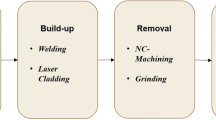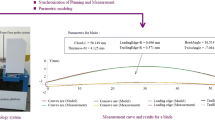Abstract
Blade geometry plays an extremely important role in the aerodynamic performance of aero-engine. However, in the adaptive machining process of a near-net-shape blade, it is important for an application engineer to reconstruct an actual profile with high-precision measurement data in a short time. This paper presents an efficient measurement to meet the requirement for digital information in the adaptive machining, which is also intimately associated with the previous work in reconstruction (Zhang et al. in Int J Adv Manuf Technol 2015:1–16, 2015). Comparing with conventional measurement, the proposed method can not only improve the utilization of measurement data from multi-sensor system but also consider the uncertainties of measurement and localization in data merging. Concretely speaking, the low-precision data from non-contact measurement device is used for establishing possible substitute models. The modified Bayesian information (Modi_BIC) criterion based on Bayesian statistics is introduced as the principle to select the model structure. In order to reduce misalignment errors of the selected substitute model, the statistical analysis of Fisher information matrix is applied to determine registration points. Based on this, the uncertainties can be given in the form of variation boundaries. Comparisons with the specified tolerance band determine a set of re-measured points by using a contact measurement device. The high-precision data can be merged with the selected substitute model by means of free form deformation (FFD) technique. The final measurement data is provided in the form of skinning surface that is consistent to the reverse modeling methodology of aero-engine blade. Moreover, some practical examples are given to demonstrate the effectiveness and superiority of the proposed method.
Similar content being viewed by others
References
Dong Y, Zhang D, Bu K, Dou Y, Wang W (2011) Geometric parameter-based optimization of the die profile for the investment casting of aerofoil-shaped turbine blades. Int J Adv Manuf Technol 57(9–12):1245–1258
Makem JE, Ou H, Armstrong CG (2012) A virtual inspection framework for precision manufacturing of aerofoil components. Comput Aided Des 44(9):858–874
Gao J, Chen X, Yilmaz O, Gindy N (2008) An integrated adaptive repair solution for complex aerospace components through geometry reconstruction. Int J Adv Manuf Technol 36(11–12):1170–1179
Lin AC, Hui-Chin C (2011) Automatic 3D measuring system for optical scanning of axial fan blades. Int J Adv Manuf Technol 57(5–8):701–717
Cuesta E, Rico JC, Fernández P, Blanco D, Valiño G (2009) Influence of roughness on surface scanning by means of a laser stripe system. Int J Adv Manuf Technol 43(11–12):1157–1166
Erkan T, Mayer R, Woźniak A (2011) Surface probing simulator for the evaluation of CMM probe radius correction software. Int J Adv Manuf Technol 55(1–4):307–315
Chen LC, Lin GCI (1997) A vision-aided reverse engineering approach to reconstructing free-form surfaces. Robot Comput Integr Manuf 13(4):323–336
Carbone V, Carocci M, Savio E, Sansoni G, De Chiffre L (2001) Combination of a vision system and a coordinate measuring machine for the reverse engineering of freeform surfaces. Int J Adv Manuf Technol 17(4):263–271
Lu K, Wang W (2015) A multi-sensor approach for rapid and precise digitization of free-form surface in reverse engineering. Int J Adv Manuf Technol 2015:1–12
Xie ZX, Wang JG, Zhang QM (2005) Complete 3D measurement in reverse engineering using a multi-probe system. Int J Mach Tools Manuf 45(12):1474–1486
Sładek J, Błaszczyk PM, Kupiec M, Sitnik R (2011) The hybrid contact–optical coordinate measuring system. Measurement 44(3):503–510
Yu M, Zhang Y, Li Y, Zhang D (2013) Adaptive sampling method for inspection planning on CMM for free-form surfaces. Int J Adv Manuf Technol 67(9–12):1967–1975
Ainsworth I, Ristic M, Brujic D (2000) CAD-based measurement path planning for free-form shapes using contact probes. Int J Adv Manuf Technol 16(1):23–31
Obeidat SM, Raman S (2009) An intelligent sampling method for inspecting free-form surfaces. Int J Adv Manuf Technol 40(11–12):1125–1136
Li YF, Liu ZG (2003) Method for determining the probing points for efficient measurement and reconstruction of freeform surfaces. Meas Sci Technol 14(8):1280
Mehrad V, Xue D, Gu P (2014) Robust localization to align measured points on the manufactured surface with design surface for freeform surface inspection. Comput Aided Des 53:90–103
Mohaghegh K, Sadeghi MH, Abdullah A (2007) Reverse engineering of turbine blades based on design intent. Int J Adv Manuf Technol 32(9–10):1009–1020
Yan Z, Yang BD, Menq CH (1999) Uncertainty analysis and variation reduction of three dimensional coordinate metrology. Part 1: geometric error decomposition. Int J Mach Tools Manuf 39(8):1199–1217
Mehrad V, Xue D, Gu P (2013) Prediction of surface reconstruction uncertainties for freeform surface inspection. Measurement 46(8):2682–2694
Sederberg TW, Parry SR (1986) Free-form deformation of solid geometric models. Comput Graph 20:151–160
Ke Y, Fan S, Zhu W, Li A, Liu F, Shi X (2006) Feature-based reverse modeling strategies. Comput Aided Des 38(5):485–506
Ou H, Wang P, Lu B, Long H (2012) Finite element modelling and optimization of net-shape metal forming processes with uncertainties. Comput Struct 90:13–27
Piegl LA, Tiller W (1997) The NURBS book. Springer, New York
Torr PHS (2002) Bayesian model estimation and selection for epipolar geometry and generic manifold fitting. Int J Comput Vis 50(1):35–61
Khameneifar F, Feng HY (2014) Airfoil profile reconstruction under the uncertainty of inspection data points. Int J Adv Manuf Technol 71(1–4):675–683
Xiong Z, Wang MY, Li Z (2004) A near-optimal probing strategy for workpiece localization. IEEE Trans Robot 20(4):668–676
Whaite P, Ferrie FP (1997) Autonomous exploration: driven by uncertainty. IEEE Trans Pattern Anal Mach Intell 19(3):193–205
Besl PJ, McKay ND (1992) Method for registration of 3-D shapes. Robotics-DL tentative. International Society for Optics and Photonics 586–606
Mehrad V, Xue D, Gu P (2013) Inspection of freeform surfaces considering uncertainties in measurement, localization and surface reconstruction. Meas Sci Technol 24(8):085008
Myers RH, Montgomery DC, Anderson-Cook CM (2009) Response surface methodology: process and product optimization using designed experiments. Wiley
Huang Y, Qian X (2008) An efficient sensing localization algorithm for free-form surface digitization. J Comput Inf Sci Eng 8(2):021008
Wang J, Jiang X, Blunt LA, Leach RK, Scott PJ (2012) Intelligent sampling for the measurement of structured surfaces. Meas Sci Technol 23(8):085006
Zhang Y, Chen ZT, Ning T (2015) Reverse modeling strategy of aero-engine blade based on design intent. Int J Adv Manuf Technol 2015:1–16
Author information
Authors and Affiliations
Corresponding author
Rights and permissions
About this article
Cite this article
Zhang, Y., Chen, ZT. & Ning, T. Efficient measurement of aero-engine blade considering uncertainties in adaptive machining. Int J Adv Manuf Technol 86, 387–396 (2016). https://doi.org/10.1007/s00170-015-8155-2
Received:
Accepted:
Published:
Issue Date:
DOI: https://doi.org/10.1007/s00170-015-8155-2




